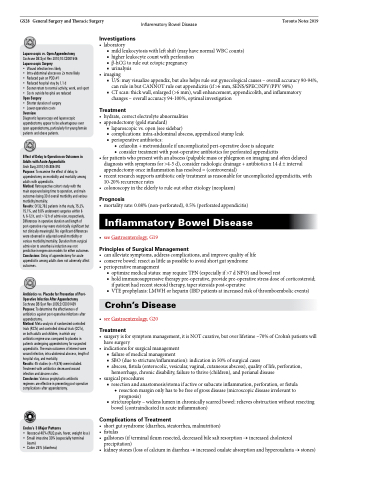Page 430 - TNFlipTest
P. 430
GS28 General Surgery and Thoracic Surgery Inflammatory Bowel Disease Toronto Notes 2019
Laparoscopic vs. Open Appendectomy
Cochrane DB Syst Rev 2010;10:CD001546
Laparoscopic Surgery
• Woundinfectionlesslikely
• Intra-abdominalabscesses2xmorelikely
• ReducedpainonPOD#1
• Reducedhospitalstayby1.1d
• Soonerreturntonormalactivity,work,andsport • Costsoutsidehospitalarereduced
Open Surgery
• Shorterdurationofsurgery
• Loweroperationcosts
Overview
Diagnostic laparoscopy and laparoscopic appendectomy appear to be advantageous over open appendectomy, particularly for young female patients and obese patients.
Effect of Delay to Operation on Outcomes in Adults with Acute Appendicitis
Arch Surg 2010;145:886-892
Purpose: To examine the effect of delay to appendectomy on morbidity and mortality among adults with appendicitis.
Method: Retrospective cohort study with the
main exposure being time to operation, and main outcomes being 30 d overall morbidity and serious morbidity/mortality.
Results: Of 32,782 patients in the study, 75.2%, 15.1%, and 9.8% underwent surgeries within 6
h, 6-12 h, and >12 h of admission, respectively. Differences in operative duration and length of post-operative stay were statistically significant but not clinically meaningful. No significant differences were observed in adjusted overall morbidity or serious morbidity/mortality. Duration from surgical admission to anesthesia induction was not predictive in regression models for either outcomes. Conclusions: Delay of appendectomy for acute appendicitis among adults does not adversely affect outcomes.
Antibiotics vs. Placebo for Prevention of Post- Operative Infection After Appendectomy Cochrane DB Syst Rev 2005;3:CD001439 Purpose: To determine the effectiveness of antibiotics against post-operative infections after appendectomy.
Method: Meta-analysis of randomized controlled trials (RCTs) and controlled clinical trials (CCTs),
on both adults and children, in which any
antibiotic regime was compared to placebo in patients undergoing appendectomy for suspected appendicitis. The main outcomes of interest were wound infection, intra-abdominal abscess, length of hospital stay, and mortality.
Results: 45 studies (n=9,576) were included. Treatment with antibiotics decreased wound infection and abscess rates.
Conclusion: Various prophylactic antibiotic regimens are effective in preventing post-operative complications after appendectomy.
Crohn’s 3 Major Patterns
• Ileocecal 40% (RLQ pain, fever, weight loss)
• Small intestine 30% (especially terminal
ileum)
• Colon 25% (diarrhea)
Investigations
• laboratory
■ mild leukocytosis with left shift (may have normal WBC counts) ■ higher leukocyte count with perforation
■ β-hCG to rule out ectopic pregnancy
■ urinalysis
• imaging
■ U/S: may visualize appendix, but also helps rule out gynecological causes – overall accuracy 90-94%,
can rule in but CANNOT rule out appendicitis (if >6 mm, SENS/SPEC/NPV/PPV 98%)
■ CT scan: thick wall, enlarged (>6 mm), wall enhancement, appendicolith, and inflammatory
changes – overall accuracy 94-100%, optimal investigation
Treatment
• hydrate,correctelectrolyteabnormalities • appendectomy (gold standard)
■ laparoscopic vs. open (see sidebar)
■ complications: intra-abdominal abscess, appendiceal stump leak ■ perioperative antibiotics:
◆ cefazolin + metronidazole if uncomplicated peri-operative dose is adequate
◆ consider treatment with post-operative antibiotics for perforated appendicitis
• for patients who present with an abscess (palpable mass or phlegmon on imaging and often delayed
diagnosis with symptoms for >4-5 d), consider radiologic drainage + antibiotics x 14 d ± interval
appendectomy once inflammation has resolved = (controversial)
• recent research supports antibiotic only treatment as reasonable for uncomplicated appendicitis, with
10-20% recurrence rates
• colonoscopyintheelderlytoruleoutotheretiology(neoplasm)
Prognosis
• mortality rate: 0.08% (non-perforated), 0.5% (perforated appendicitis)
Inflammatory Bowel Disease
• seeGastroenterology,G19
Principles of Surgical Management
• can alleviate symptoms, address complications, and improve quality of life • conserve bowel: resect as little as possible to avoid short gut syndrome
• perioperativemanagement
■ optimize medical status: may require TPN (especially if >7 d NPO) and bowel rest
■ hold immunosuppressive therapy pre-operative, provide pre-operative stress dose of corticosteroid;
if patient had recent steroid therapy, taper steroids post-operative
■ VTE prophylaxis: LMWH or heparin (IBD patients at increased risk of thromboembolic events)
Crohn’s Disease
• see Gastroenterology, G20
Treatment
• surgeryisforsymptommanagement,itisNOTcurative,butoverlifetime~70%ofCrohn’spatientswill have surgery
• indications for surgical management
■ failure of medical management
■ SBO (due to stricture/inflammation): indication in 50% of surgical cases
■ abscess, fistula (enterocolic, vesicular, vaginal, cutaneous abscess), quality of life, perforation,
hemorrhage, chronic disability, failure to thrive (children), and perianal disease • surgical procedures
■ resection and anastomosis/stoma if active or subacute inflammation, perforation, or fistula ◆ resection margin only has to be free of gross disease (microscopic disease irrelevant to
prognosis)
■ stricturoplasty – widens lumen in chronically scarred bowel: relieves obstruction without resecting
bowel (contraindicated in acute inflammation)
Complications of Treatment
• shortgutsyndrome(diarrhea,steatorrhea,malnutrition)
• fistulas
• gallstones (if terminal ileum resected, decreased bile salt resorption → increased cholesterol
precipitation)
• kidneystones(lossofcalciumindiarrhea→increasedoxalateabsorptionandhyperoxaluria→stones)


